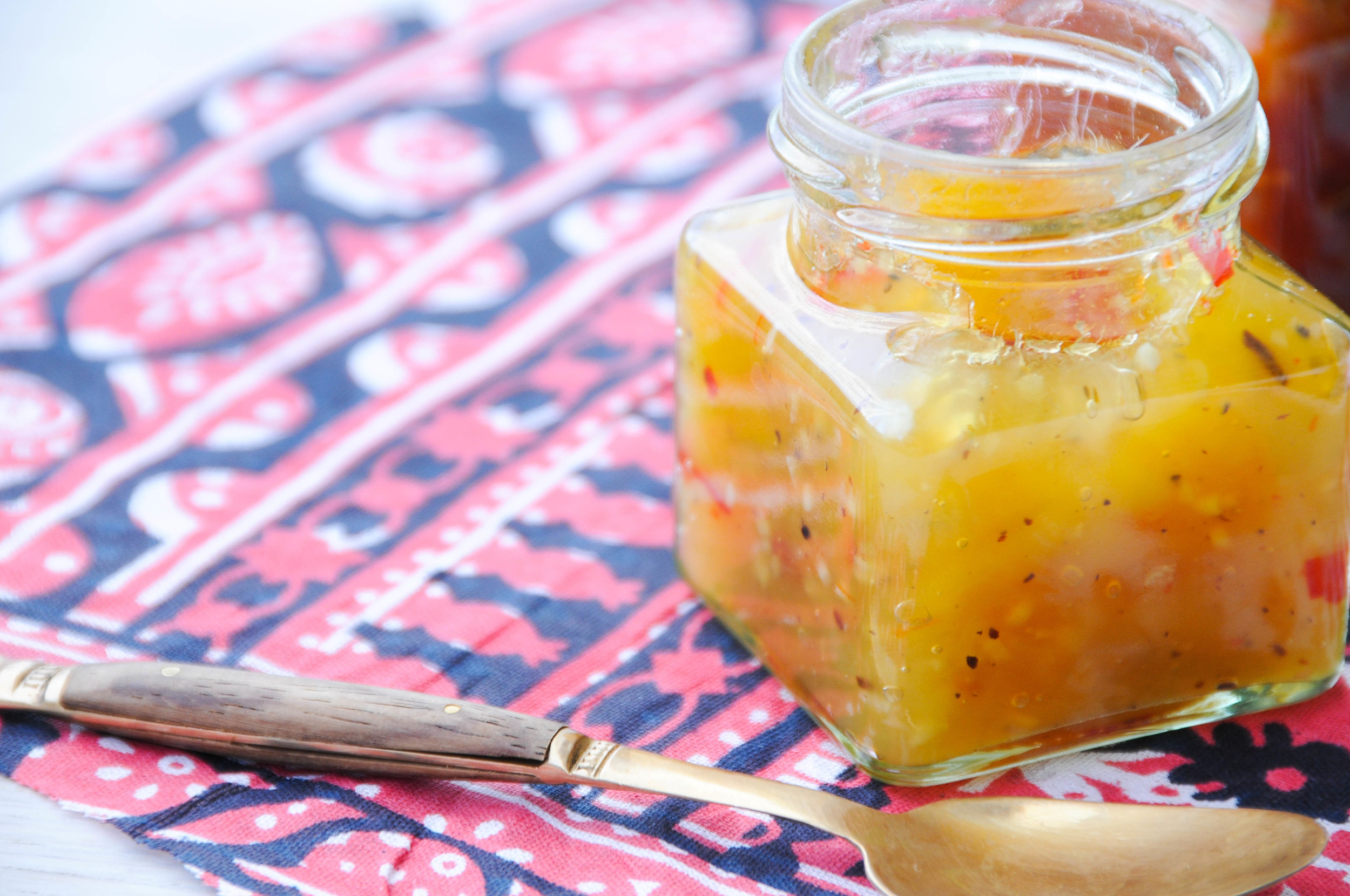As we wander between the plantings of Zanizbar’s spice fields our local guide (turned MD) is dispensing homeopathic advice. Each crop that we pass has its own purported benefits – ‘red cinnamon bark for cholesterol,’ ‘cloves for nausea,’ ‘nutmeg for restoring strength,’ and lemongrass for a particular kind of urinary problem described to us in more detail than warrants repeating on a blog about food. ‘And what’s this good for?’ I venture, leaning down to examine a tiny chilli plant crowned with fiery-looking red pods. ‘Keeping warm in the rainy season,’ comes the answer. Well, fair enough. ‘It is also,’ he adds, ‘very good for chutney.’ Now we are talking, and looking out across the loosely ordered spice groves interspersed with tropical fruit trees and coconut palms, the whole place seems suddenly to offer up a zillion different chutney combinations just waiting to be trialled. Fortunately, at this point our guide reveals that he is the son of chef, and swaps the medical advice for chutney preparation tips...
‘Mango, chilli, garlic, onion, ginger, peppercorns’ he lists, ‘but only if it is green mango.’ ‘With ripe mango, use ginger, and coconut, but never tomato, nor onion, or garlic. ‘For green mango, it is OK to add tomato, or grated coconut, but not both, and if coconut, again no onion or garlic.’ The instructions are delivered rapid fire, and riddled with a complexity of rules regarding what goes with what. Back at home, looking back over my hastily scribbled notes, I can’t claim to necessarily have gotten everything down with much accuracy. In preparing the below recipes however, I did try to abide some of the basic onion, garlic, no onion, no garlic rules (these seemed to make pretty good sense). Other than this, I can’t make any serious claims regarding the authenticity of the recipes below, what I can say though is that for each, I have tried to make the best possible use of the beautiful tropical ingredients that grow so symbiotically alongside each other in the Zanzibari spice fields, figuring that, to an extent at least, things that grow together should go together.
If you are very keen to channel some tropical enthusiasm, I’d definitely recommend tracking down a whole coconut for these recipes and cracking it at home. Back when I was the owner of power tools (pre the days of apartment living), cracking a coconut would have definitely involved a drill. A bit of research and improvisation however yielded up the following apartment-dwellers-lite methodology: 1) Take something metal, (ideally, a nail, but failing this, an ice pick, or any sharp utensil, and, using a hammer (or a very sturdy rolling pin!), tap this through the three ‘eyes’ of the coconut; 2) Invert the coconut over a glass to drain out the fresh coconut milk, (you can drink this straight away, or put it aside to use for cooking); 3) Then, holding the coconut in your palm with its eyes facing up, make a series of sharp taps with a hammer (or the rolling pin) around the ‘equator’ of the spherical nut. After a few taps along its central horizontal axis, the hard coconut should miraculously break cleanly into two halves. Roast the coconut halves at 200˚C for about 15 minutes, or until the white flesh begins to lightly colour. One cooled, you should be able to remove large chucks of the coconut flesh cleanly from the outer shell by hand, or with a small, study knife. To use in the below recipes, simply grate the coconut pieces using a fine grater.
Last of all, the only other thing you may want to consider for these chutney recipes is picking up some rubber-sealed preserving jars. With the exception of the green mango chutney, the recipes below are not really designed to be stored for longer periods of time, but if you use rubber-seal preserving jars, and sterilise these and their lids by boiling at 100˚C for 10 minutes, you should get a few months longevity from the Sweet Mango and Tangy Tomato chutneys as well.
Sweet Mango Chutney
Unlike the Indian pickled mango chutney, this recipe is for a sweet, fresh-tasting chutney, that really retains the flavour of the mangos. It can be eaten alongside curries, but is also nice with cold roast beef and especially, with roast pork.
Ingredients
(Makes 300ml of chutney – so, two jars of the small 150ml size pictured)
- 2 large mangos
- 4cm piece of fresh ginger – finely grated
- 1 red chilli – deseeded and finely chopped
- 4 tablespoons caster sugar
- ¼ cup of freshly grated coconut (substitute desiccated coconut if you don’t have access to fresh coconut)
- 2 teaspoons of tamarind concentrate
- 1 teaspoon salt
Peel away the skin of the mangos and, using a sharp knife, slice as much flesh as possible away from the central pit. Roughly chop the flesh into large cubes. Place the cubed mango, freshly grated ginger, chilli, and caster sugar in a medium saucepan, and simmer gently, stirring to dissolve the sugar.
After 15 minutes simmering, add the grated coconut, tamarind concentrate, and the salt. Stir through to combine.
Simmer for a further 15 minutes until the chutney has reduced and become sticky. Do a quick taste test to determine whether it needs any more salt, or tamarind (for tartness), and adjust accordingly if necessary.
Spoon into a sterilised jar, and seal. This chutney can be eaten straight away – it does not need time in the jar to develop. Properly sterilised, unopened jars can be stored for up to three months.
Tangy Tomato Chutney
As the name suggests, this chutney has a bit of a kick, courtesy of the balsamic vinegar added at the end. The curry leaves are left whole, which I think presents beautifully in the jar, and adds a nice variance in texture to the chutney. The coconut is also in there for texture as well as flavour (and because I had a whole one of these to get through!). If you are not a big coconut fan, feel free to leave it out. Like the sweet mango, this chutney is also ready to be eaten straight away. Again, if you’ve done all the sterilisation stuff properly, it can also be stored unopened for a few months.
Ingredients
(Makes 300ml of chutney)
- Small amount of canola or sunflower oil
- 1 brown onion – finely chopped
- Thumb-sized piece of fresh ginger (approx. 6cm) – finely chopped
- 3 cloves garlic – crushed
- Small handful of curry leaves (approx. 12 small leaves)
- 1 green chilli – deseeded and finely chopped
- 3 level tablespoons freshly grated coconut (or substitute desiccated coconut)
- 400ml tin of crushed tomatoes
- 2 tablespoons brown sugar
- 3 tablespoons balsamic vinegar
Heat the oil in a medium saucepan, add the onion and gently fry until soft, but not coloured. Add the ginger, garlic, curry leaves, chilli, and grated coconut, along with a little more oil if the pan has dried out, and cook for a couple more minutes, stirring in order that the garlic does not burn. When the coconut has begun to lightly colour, add the tomatoes, brown sugar, and balsamic vinegar. Cook everything together for up to 30 minutes, or until you have achieved a reduced and pleasingly chutney-like consistency.
Spoon the chutney into sterilised jars, adding a covering layer of oil to reach the very top of the jar before sealing with the lid if you are intending to store for any length of time.
Serve with dry curries, or cold meats, or with anything else that you think would benefit from tomato-y tang
Green Mango Chutney
Unlike the previous two recipes, this one takes a bit of forward planning. Firstly, the green mangoes have to be pre-prepared and set aside overnight, and secondly, the chutney tastes its best after at least a month or so developing in the jar, so it is a long wait before you get to sample… Designed to be eaten alongside deep-fried samosas, and other rich snacks, this chutney is all about providing a strong complimentary but contrasting flavour – although not a pickle exactly, I would definitely say that it is moving more towards that end of the chutney-pickle spectrum.
Ingredients
(Makes 300ml of chutney)
- 4 green mangos
- 7 whole peppercorns
- 5 cardamom pods
- 1 clove garlic – finely chopped
- Thumb-sized piece of ginger (approx. 6cms) – finely grated
- 1 red chilli – deseeded and finely chopped
- Salt for sprinkling
- ½ cup caster sugar
- ½ cup of white wine vinegar
- 1 lime – juice only
Peel the green mangos, cut the flesh into small cubes, and place these into a medium sized saucepan. Next, remove the seeds from two of the cardamom pods, discarding the outer pods. Crush the cardamom seeds and whole peppercorns together using a mortar and pestle until you have a fine powder. Sprinkle this over the cubed green mangos in the saucepan. Also add the remaining three whole cardamom pods, the chopped garlic, grated ginger, and chopped red chilli to the mango in the saucepan. Mix everything together, and then sprinkle with a generous amount of salt (a couple of tablespoons should do).
Cover, and set aside overnight. The next morning, the salt will have drawn a large amount of fluid from the mangos. Drain off the fluid using a fine sieve, so as to retain the spices and flavourings as much as possible. A lot of the salt will have dissolved in the liquid, so will not be carried forward into the chutney.
Now place the saucepan over a low heat, add the sugar and vinegar, and stir to dissolve. Simmer for 30 minutes, or until the mango pieces have broken down and you have a thick, sticky chutney. Last of all, add the lime juice and stir this through.
Spoon into sterilised jars and place in a cool dark cupboard to mature for at least one month, but up to three months. After this time, the chutney will have developed nicely and will taste its best. Unopened jars should store for up to a year, once opened store the chutney in the fridge.







